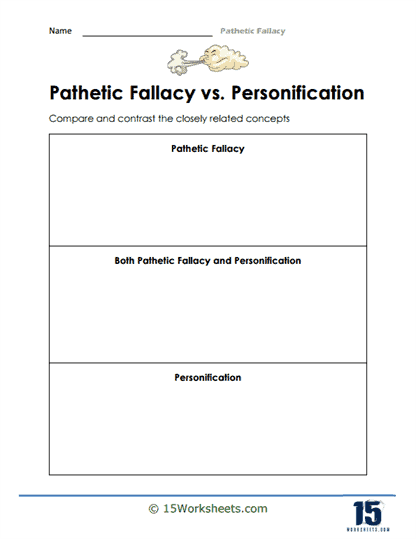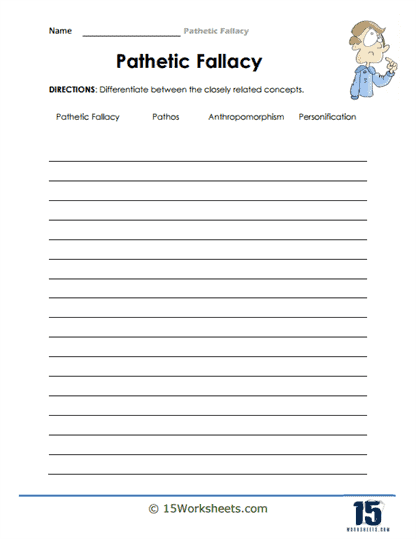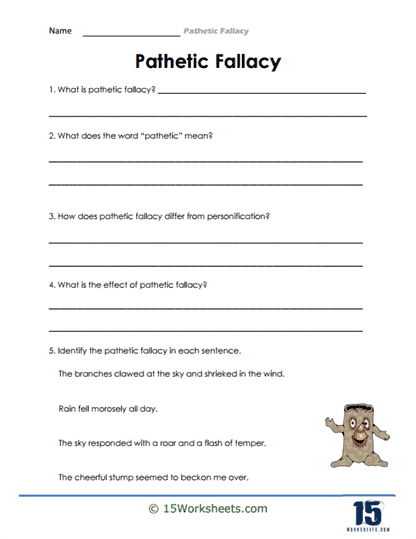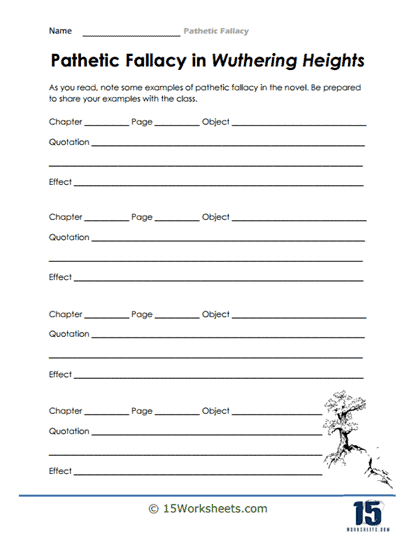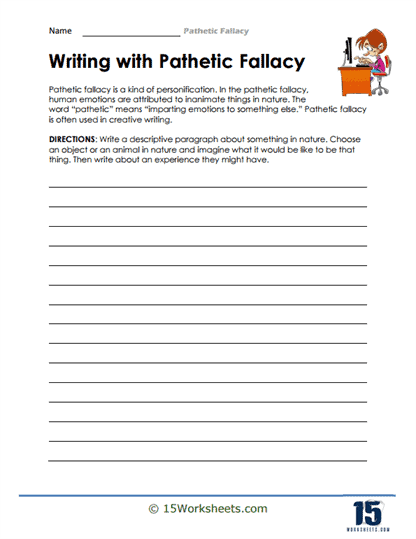Pathetic Fallacy Worksheets
About These 15 Worksheets
Pathetic fallacy, a literary device, imbues inanimate objects or nature with human emotions, enhancing the narrative’s emotional depth and fostering a deeper connection between the reader and the text. Pathetic Fallacy Worksheets are essential tools in language arts education, aiding students in comprehending, identifying, and analyzing this literary technique. These worksheets encompass a variety of exercises designed to refine students’ language arts and reading skills through hands-on practice and critical thinking.
Through guided practice and hands-on exercises, students embark on a journey of discovery, exploring the intricate interplay between language, emotion, and imagination, and emerging as thoughtful, perceptive readers and writers equipped to navigate the complexities of the literary landscape.
1. Identification Exercises
One of the primary exercises found in Pathetic Fallacy Worksheets involves identifying instances of the literary device within a given text. Students are tasked with reading excerpts from literature, ranging from classic novels to contemporary poems, and pinpointing examples of pathetic fallacy. By engaging with diverse texts, students develop a nuanced understanding of how authors employ this technique across different genres and literary periods.
Example Exercise – Read the following passage from Emily Brontë’s “Wuthering Heights” and identify instances of pathetic fallacy:
“The intense horror of nightmare came over me – I tried to draw back my arm, but the hand clung to it, and a most melancholy voice sobbed, ‘Let me in-let me in!'”
Students would then identify the elements of nature or inanimate objects attributed with human emotions or characteristics, such as the “intense horror” and the “melancholy voice,” enhancing their comprehension of pathetic fallacy.
2. Analysis and Interpretation Tasks
Another key component of Pathetic Fallacy Worksheets involves analyzing the effects of the literary device on the text’s tone, mood, and overall meaning. Students delve deeper into the emotional resonance created by pathetic fallacy, examining how it contributes to character development, plot progression, and thematic exploration. Through guided questions and discussions, students learn to articulate their interpretations coherently and support them with textual evidence.
Example Exercise – Discuss how the author’s use of pathetic fallacy in the following poem contributes to its overall mood and theme:
“The leaves danced in the wind, whispering secrets to the barren trees,
As the storm raged within, mirroring the turmoil of my soul’s unease
Students would analyze how the imagery of dancing leaves and whispering secrets reflects the speaker’s internal turmoil, emphasizing the theme of inner conflict and emotional turbulence.
3. Creative Writing Prompts
Pathetic Fallacy Worksheets often incorporate creative writing prompts that encourage students to employ the literary device in their own compositions. By crafting original narratives or poems infused with pathetic fallacy, students deepen their understanding of its mechanics and explore its creative potential as a storytelling tool. This hands-on approach fosters creativity, imagination, and expressive writing skills.
Example Exercise – Write a short story where the setting mirrors the protagonist’s emotional journey, utilizing pathetic fallacy to convey mood and atmosphere effectively.
Students would create narratives where the environment reflects the protagonist’s emotional state, demonstrating their mastery of pathetic fallacy in a creative context.
4. Comparative Analysis Tasks
In some Pathetic Fallacy Worksheets, students compare and contrast different examples of the literary device within various texts. This exercise fosters critical thinking skills as students examine how authors from different cultural backgrounds and literary traditions employ pathetic fallacy to achieve similar or divergent effects. Through comparative analysis, students gain insights into the universality and versatility of the literary device.
Example Exercise – Compare the use of pathetic fallacy in William Wordsworth’s “I Wandered Lonely as a Cloud” and Langston Hughes’s “Dream Variations,” discussing how each poet utilizes nature imagery to convey themes of longing and liberation.
Students would explore how Wordsworth and Hughes employ pathetic fallacy to evoke distinct emotional responses and convey nuanced thematic elements, enriching their understanding of the device’s interpretive possibilities.
5. Group Discussions and Socratic Seminars
Pathetic Fallacy Worksheets may incorporate group discussions or Socratic seminars, providing students with opportunities to engage in collaborative learning and exchange ideas. Through facilitated dialogue, students analyze selected texts, share their interpretations, and offer feedback to their peers. These discussions foster critical thinking, communication skills, and a deeper appreciation for the complexities of literature.
Example Exercise – Participate in a group discussion analyzing the use of pathetic fallacy in a short story by Edgar Allan Poe, considering its impact on character development and narrative tension.
Students would engage in an open-ended dialogue, exploring the nuances of Poe’s storytelling techniques and reflecting on how pathetic fallacy contributes to the psychological depth of his characters and the atmospheric tension of his narratives.
The Benefits Of These Worksheets
Practicing these worksheets offers numerous benefits for students, enhancing their language arts and reading skills in multifaceted ways:
Enhanced Textual Analysis – By identifying and analyzing instances of pathetic fallacy, students develop keen observational skills and learn to decipher the underlying symbolism and metaphorical significance embedded within literary texts.
Critical Thinking Development – Engaging with Pathetic Fallacy Worksheets cultivates critical thinking skills as students evaluate the effectiveness of the literary device in conveying mood, tone, and thematic elements, fostering deeper insights into the author’s intended message.
Creative Expression – Through creative writing prompts, students explore their imagination and hone their writing skills, experimenting with language and imagery to evoke emotions and create vivid narrative worlds enriched with pathetic fallacy.
Cultural and Literary Appreciation – Comparative analysis tasks encourage students to explore diverse literary traditions and cultural perspectives, fostering a deeper appreciation for the richness and diversity of world literature.
Communication and Collaboration – Group discussions and Socratic seminars promote effective communication skills as students articulate their interpretations, engage in respectful dialogue, and collaborate with their peers to construct meaning collaboratively.
What is the Literary Device of Pathetic Fallacy?
Pathetic fallacy is a literary device that attributes human emotions or characteristics to nature, inanimate objects, or animals. This term was first coined by the art critic John Ruskin in his 1856 book “Modern Painters,” where he criticized the tendency of poets to assign human feelings to the natural world. Despite Ruskin’s critical view, the pathetic fallacy has become a cherished and effective tool in literature, used to enhance the narrative, establish mood, and deepen the connection between the reader and the text.
The Main Defining Feature
The main defining feature of pathetic fallacy is its personification of elements of the natural world or inanimate objects, imbuing them with human emotions or behaviors. Unlike simple personification, which might give human qualities to non-human entities, pathetic fallacy specifically relates to the projection of human emotions onto the external environment. It often reflects the inner feelings of characters, thereby enriching the reader’s understanding of the narrative’s emotional landscape.
Characteristics of Pathetic Fallacy
Emotional Reflection – Pathetic fallacy often mirrors the emotional state of characters, providing an external manifestation of their inner feelings.
Atmospheric Enhancement – It creates a specific mood or atmosphere that aligns with the narrative’s tone, influencing the reader’s emotional response.
Symbolism – The use of pathetic fallacy can symbolize broader themes or conflicts within the story, such as turmoil, love, or despair.
Enhanced Imagery – This device enriches the narrative’s imagery, making descriptions more vivid and engaging by blending the natural with the emotional.
Examples of Pathetic Fallacy in Literature
1. William Shakespeare’s “Macbeth”
In “Macbeth,” Shakespeare employs pathetic fallacy to set the tone for the play’s tragic and ominous events. After King Duncan’s murder, Ross comments on the dark and unruly night, suggesting that nature itself is responding to the regicide – “By the clock, ’tis day, And yet dark night strangles the travelling lamp The weather mirrors the unnatural act of regicide and the turmoil it unleashes in the kingdom, emphasizing the disruption of natural order and the characters’ inner turmoil.
2. Mary Shelley’s “Frankenstein”
Mary Shelley’s “Frankenstein” uses pathetic fallacy to reflect the novel’s themes of isolation, despair, and the monstrous. During pivotal moments in Victor Frankenstein’s narrative, the setting often mirrors his emotional state. For instance, the stormy night that brings the monster to life reflects Victor’s tumultuous emotions and the horrific consequences of his overreaching ambition. The tempestuous weather serves as a foreboding backdrop that amplifies the novel’s Gothic atmosphere and Victor’s feelings of dread.
3. Charles Dickens’s “Great Expectations”
In “Great Expectations,” Dickens uses pathetic fallacy to reflect Pip’s emotional states and the novel’s thematic concerns. The misty marshes near Pip’s home are often described in ways that mirror Pip’s confusion, uncertainty, and moral dilemmas. The fog becomes a metaphor for Pip’s lack of clarity about his identity and future, and its lifting symbolizes moments of revelation and understanding. Through the environment, Dickens conveys Pip’s emotional journey and the transformative power of love and conscience.
The Effect on the Reader
Pathetic fallacy deepens the reader’s engagement with the text by creating a vividly emotional landscape that mirrors the characters’ inner lives. It enriches the narrative’s atmosphere, setting an appropriate tone that can enhance the thematic depth and emotional resonance of the story. By aligning the environment with the characters’ emotions, authors forge a more immersive and emotionally textured reading experience. This device encourages readers to feel the emotional undercurrents of the narrative more acutely, fostering a deeper empathy for the characters and a greater appreciation for the thematic nuances of the story.
Pathetic fallacy is a potent literary device that enables authors to bridge the gap between the external world and the internal emotional landscape of their characters. By personifying nature or inanimate objects with human emotions, authors can enhance the narrative’s mood, deepen thematic exploration, and enrich the reader’s engagement with the text. Whether it’s the ominous storms of “Macbeth,” the tempestuous weather of “Frankenstein,” or the misty marshes of “Great Expectations,” pathetic fallacy remains a timeless tool in the arsenal of literary techniques, capable of transforming the mundane into the profoundly expressive.






